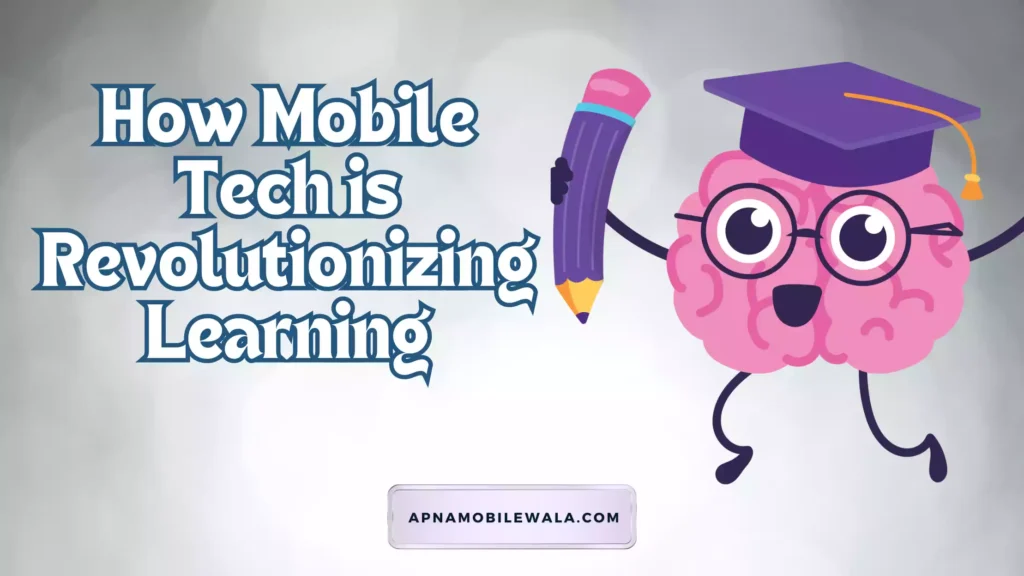Learning on the Go: The Impact of Mobile Technology on Education
The way we learn is undergoing a revolution, and mobile technology is at the forefront. Gone are the days of bulky textbooks and confined classrooms. Today’s students have a powerful learning tool in their pockets – their smartphones and tablets. But how exactly is mobile technology impacting education? Let’s dive in and explore the exciting possibilities:
1. Increased Accessibility and Flexibility:
Mobile devices make education more accessible than ever before. Students can access learning materials, lectures, and online courses anytime, anywhere. This is a game-changer for busy students, those in remote locations, or those who require flexible learning schedules.
2. Enhanced Engagement and Interaction:
Mobile learning goes beyond static textbooks. Interactive apps, simulations, and educational games can transform dry subjects into engaging experiences. Students can learn by doing, fostering a deeper understanding of concepts. Additionally, mobile devices allow for easy collaboration and communication between students and teachers, creating a more interactive learning environment.
3. Personalized Learning Experiences:
Mobile apps can cater to individual learning styles and pace. Students can access content at their own level and revisit challenging topics as needed. Educational apps can even track student progress and provide personalized recommendations to fill knowledge gaps.
4. A World of Resources at Your Fingertips:
Imagine having a mini-library or a virtual tutor in your pocket! Mobile devices offer instant access to a vast amount of educational resources – online encyclopedias, educational videos, and educational podcasts. Students can delve deeper into topics, conduct research, and explore new areas of interest with ease.
5. Bridging the Gap Between Classroom and Real-World Learning:
Mobile technology can bridge the gap between theoretical knowledge and real-world application. Educational apps can use augmented reality (AR) to overlay virtual objects onto the physical world, allowing students to visualize concepts in a more interactive way. Imagine exploring historical landmarks through AR or conducting virtual science experiments on your phone!
Challenges and Considerations:
While mobile technology offers immense potential, there are challenges to consider:
- Digital Divide: Not all students have equal access to mobile devices and reliable internet connections.
- Distractions: Mobile devices can be a source of distraction, requiring strategies to promote focused learning.
- Content Quality: The quality and educational value of mobile apps can vary greatly. Careful selection is crucial.
The Power in Your Pocket: Why Mobile Learning Matters in Education
Education is undergoing a seismic shift, and mobile technology is at the forefront. Imagine a classroom where textbooks are replaced by interactive apps, lectures come alive with virtual reality simulations, and students can access a world of knowledge anytime, anywhere. This is the power of mobile learning, and it’s transforming the way we teach and learn.
Here’s why mobile learning is so important in education:
- Accessibility and Flexibility: Mobile devices break down barriers to learning. Students can access educational materials, online courses, and educational apps anytime, anywhere. This empowers busy students, those in remote locations, and those who require more flexible learning schedules.
- Engagement and Interaction: Gone are the days of passive learning. Mobile learning makes education interactive and engaging. Educational games, simulations, and quizzes can transform dry subjects into exciting experiences. Students can learn by doing, fostering a deeper understanding and a love of learning.
- Personalized Learning Paths: Mobile technology allows for a shift from a one-size-fits-all approach to education. Students can learn at their own pace, revisit challenging topics, and access content tailored to their individual learning styles and needs. Educational apps can track progress and suggest personalized recommendations to fill knowledge gaps.
- A World of Resources at Your Fingertips: Mobile devices offer instant access to a vast library of educational resources – online encyclopedias, educational videos, podcasts, and more. Students can delve deeper into topics, conduct research, and explore new areas of interest with ease. This empowers them to become self-directed learners.
- Bridging the Gap Between Theory and Practice: Mobile learning can bridge the gap between theoretical knowledge and real-world application. Imagine using augmented reality (AR) apps to see historical landmarks come alive or conducting virtual science experiments on your phone! This can make learning more relevant and engaging.
Mobile learning isn’t without its challenges:
- Digital Divide: Not all students have equal access to mobile devices and reliable internet connections. Efforts to bridge this gap are crucial for equitable education.
- Distractions: Mobile devices can be a source of distraction. Strategies to promote focused learning during mobile learning activities are essential.
- Content Quality: The quality of mobile learning apps can vary greatly. Careful selection of apps that align with learning objectives and provide high-quality content is necessary.
The Future of Mobile Learning:
The future of mobile learning is bright. As technology advances, we can expect even more innovative and immersive learning experiences on mobile devices. Mobile technology has the potential to personalize education, make it more accessible and engaging, and empower students to become active participants in their own learning journeys. So, let’s harness the power of mobile technology to unlock a world of possibilities in education!
Mobile Technology in Math Class: Boon or Bane?
Mobile technology has undeniably transformed education, impacting how students learn across all subjects. But how does it specifically affect mathematics education? Let’s delve into the potential benefits and drawbacks of mobile tech on learning performance and motivation in math.
The Positive Impact:
Mobile devices can be powerful tools to enhance math learning:
- Increased Engagement and Interaction: Interactive apps, games, and simulations can make math concepts more engaging and relatable. Imagine practicing geometry through a 3D manipulation app or visualizing complex equations through animation.
- Personalized Learning: Mobile apps can tailor the learning experience to individual needs. Students can practice at their own pace, receive targeted feedback, and focus on areas requiring improvement.
- Accessibility and Resources: Math apps and online platforms offer a wealth of resources – practice problems, step-by-step explanations, and even virtual tutors – all readily available on a student’s phone or tablet.
- Visual Aids and Augmented Reality (AR): Imagine visualizing complex geometric shapes in AR or using an app to see how math concepts apply in the real world. AR can enhance understanding and make abstract concepts more concrete.
- Collaboration and Communication: Mobile tools can facilitate communication and collaboration between students, allowing them to work on problems together or share study resources.
The Potential Pitfalls:
While mobile technology offers advantages, there are potential drawbacks to consider:
- Distraction: Smartphones can be a source of distraction, especially for students who struggle with self-regulation. Implementing strategies to minimize distractions during learning activities is crucial.
- Content Quality: The educational value of mobile apps varies greatly. Educators need to carefully select apps that align with learning objectives and provide high-quality content.
- Digital Divide: Not all students have equal access to mobile devices or reliable internet connections. This can exacerbate existing educational inequalities.
- Overreliance on Technology: Mobile apps should supplement, not replace, traditional teaching methods. Developing strong foundational math skills through practice and problem-solving remains essential.
Maximizing the Benefits:
To maximize the positive impact of mobile technology in math education:
- Teachers as Guides: Educators play a crucial role in curating high-quality mobile resources and integrating them effectively into lesson plans.
- Focus and Strategy: Develop strategies to minimize distractions and encourage focused learning with mobile devices.
- Balance is Key: Mobile technology should complement traditional instruction, not replace it.
- Addressing the Divide: Schools and communities should work to bridge the digital divide and ensure equitable access to technology.
Conclusion:
Mobile technology offers a double-edged sword for math education. When used strategically and with proper guidance, it can be a powerful tool to enhance engagement, personalize learning, and improve understanding. However, it’s crucial to acknowledge and address potential drawbacks to ensure mobile technology empowers, not hinders, the learning journey in mathematics.
Thanks for Reading!
- How Will We Access Virtual Worlds on Our Phones?
- The Rise of the Subscription Phone
- Sony Xperia 1 VI Price and Review
- Realme 12 Pro Plus Review and Price
- OnePlus Nord CE4 Review and Price



